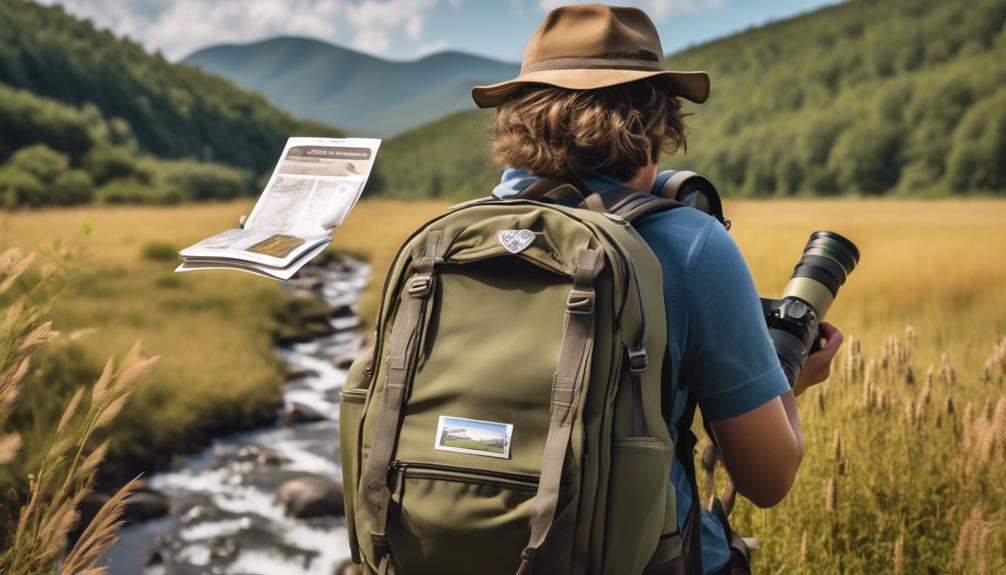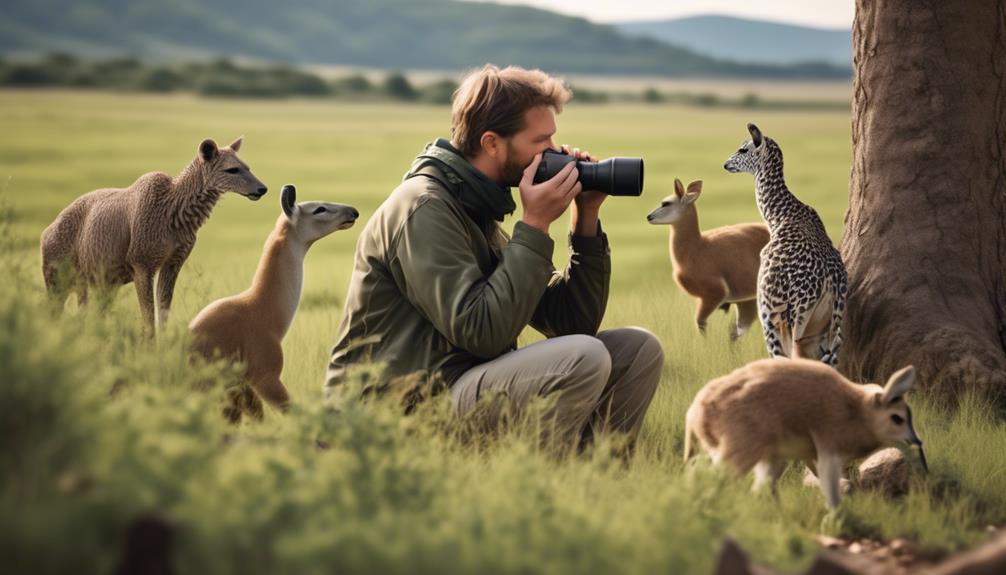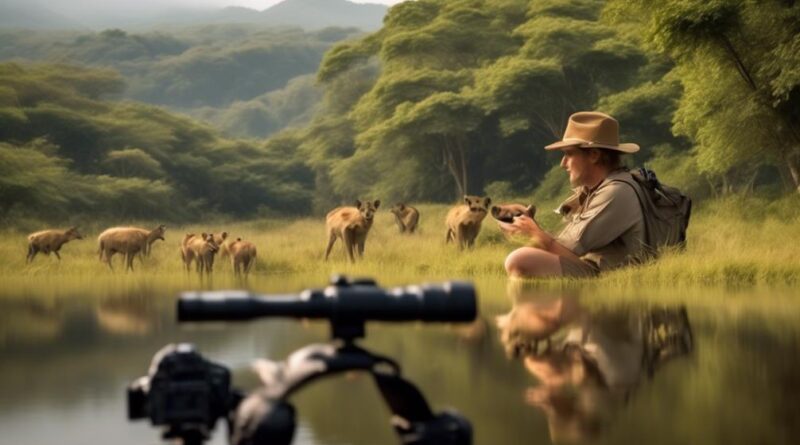5 Ethical Wildlife Watching Tips for Outdoor Travelers
Are you passionate about wildlife and eager to witness animals in their natural habitat? As an outdoor traveler, do you want to ensure that your wildlife watching experiences are ethical and respectful?
Understanding how to interact with wildlife responsibly can enhance your travel adventures while safeguarding the well-being of the creatures you encounter. By following a few key principles, you can contribute to the conservation of wildlife and make a positive impact on their lives.
But what are these essential ethical wildlife watching tips, and how can they help you become a more mindful and conscientious traveler?
Select the Right Wildlife Watching Gear

To enhance your wildlife watching experience, it's essential to select the right gear that suits the specific animals and environments you'll encounter. When choosing appropriate equipment for wildlife watching, consider investing in a good pair of binoculars. Opt for ones with a magnification of 8x to 10x and an objective lens diameter of 42mm for optimal light gathering. This will allow you to observe animals from a safe distance without disturbing them.
Additionally, a camera with a telephoto lens is essential for ethical photography. It enables you to capture high-quality images while maintaining a respectful distance from the wildlife. Ensure that your camera has a silent shutter mode to minimize noise that could startle the animals.
Responsible wildlife interaction is crucial for the well-being of the animals and the preservation of their natural habitats. When observing wildlife, practice environmental awareness by staying on designated trails and avoiding any form of littering. Choose clothing with earthy tones to blend in with the surroundings and minimize your impact on the environment. It's important to minimize any disruptions to the wildlife and their habitats.
Respect Wildlife's Natural Habitat
When respecting wildlife's natural habitat, remember to minimize disruptions to the animals and their environment by maintaining a respectful distance and staying on designated trails. Ethical wildlife watching and photography go hand in hand with wildlife preservation.
Here are some tips to help you respect wildlife's natural habitat:
- Maintain a Safe Distance: Always keep a safe distance from wildlife to avoid causing stress or disturbance to the animals. Using zoom lenses for photography can help capture close-up shots without encroaching on their space.
- Stay on Designated Trails: Venturing off designated trails can damage fragile ecosystems and disturb wildlife. Stick to marked paths to minimize your impact on the environment.
- Avoid Feeding Wildlife: Feeding wildlife disrupts their natural foraging behaviors and can make them dependent on handouts. This can lead to aggressive behavior and health issues for the animals.
- Minimize Noise and Movement: Sudden movements and loud noises can startle wildlife, causing unnecessary stress. Keep noise to a minimum and move slowly and deliberately to avoid startling the animals.
- Respect Wildlife's Routines: Be mindful of the time of day when wildlife is most active and plan your visits accordingly. This reduces the likelihood of disturbing animals during crucial feeding or resting times.
Following these tips won't only ensure the ethical treatment of wildlife but also contribute to the preservation of their natural habitats.
Maintain a Safe Distance

How can you ensure a safe distance from wildlife while observing them in their natural habitat?
When engaging in wildlife photography or simply observing animals in their natural environment, it's crucial to practice responsible wildlife tourism and adhere to the best ethical practices. Maintaining a safe distance isn't only essential for your own safety but also for the well-being and natural behavior of the animals.
When it comes to wildlife photography, it's important to use long lenses or zoom capabilities to capture close-up shots without encroaching on the animal's space. This allows you to maintain a safe distance while still obtaining high-quality photographs. Additionally, be patient and allow the wildlife to come to you, rather than approaching them.
In the context of responsible wildlife tourism, best practices include following any guidelines or rules set by park authorities or tour guides regarding how far you should stay away from the animals. These guidelines are put in place to protect both wildlife and visitors. It's also crucial to remember that the safety recommendations may vary depending on the species and the specific environment. Observing from a distance not only minimizes stress on the animals but also reduces the risk of potential conflicts.
Avoid Feeding or Approaching Wildlife
As a responsible wildlife observer, always refrain from feeding or approaching wildlife in their natural habitat. This is crucial for their well-being and for your safety. When you feed or get too close to wild animals, you disrupt their natural behaviors and can put yourself and the animals at risk.
Here are some important points to remember:
- Wildlife Photography: Instead of getting too close to animals for the perfect shot, invest in a good telephoto lens. This allows you to capture stunning photographs while maintaining a safe distance from the wildlife.
- Ethical Behavior: Show respect for the animals by observing them from a distance. Remember that they aren't there for your entertainment and shouldn't be disturbed for the sake of a photograph or a closer look.
- Responsible Tourism: Encourage others to practice responsible wildlife viewing. Set an example by not approaching or feeding animals, and kindly educate others who may not be aware of the potential harm caused by such actions.
- Wildlife Conservation: By not feeding or approaching wildlife, you contribute to their conservation. Allowing animals to maintain their natural behaviors and habitat helps in preserving the delicate balance of the ecosystem.
- Safety: Approaching wildlife, especially large or unpredictable animals, can be extremely dangerous. It's essential to prioritize your safety and that of the animals by keeping a safe distance at all times.
Observe and Minimize Your Impact

To minimize your impact while observing wildlife, practice mindfulness and awareness of your surroundings at all times. When engaging in wildlife photography, ethical considerations should always be at the forefront of your mind. Avoid disrupting the natural behavior of animals for the sake of a photograph. Use long-range lenses and natural hides to capture stunning shots without causing distress to the wildlife. Additionally, be mindful of the use of flash photography as it can startle or disturb animals, especially at night.
Responsible wildlife tourism involves community involvement and support. Seek out guided tours and experiences that actively contribute to the conservation and protection of wildlife and their habitats. Ensure that the tour operators and guides prioritize the well-being of the animals and adhere to ethical standards. By choosing wildlife experiences that support local communities, you can contribute to the preservation of natural habitats and the well-being of indigenous wildlife.
When observing wildlife, remember to minimize your physical impact on the environment. Stay on designated paths and viewing areas to avoid trampling vegetation or disturbing sensitive habitats. Keeping a safe distance from wildlife is crucial for their safety and well-being, as well as for your own. Respect any barriers or guidelines established for viewing wildlife, and always follow the instructions of knowledgeable guides or park rangers.
Be Mindful of Noise and Movement
When wildlife watching, ensure that you minimize noise and movement to avoid disturbing the natural behavior of animals. Minimizing disturbance is crucial for ethical wildlife watching practices and to capture the best wildlife photography.
- Move Slowly: Approach the wildlife slowly and steadily to avoid sudden movements that may startle the animals.
- Use Quiet Equipment: If using photography or recording equipment, ensure that it operates silently to avoid unnecessary noise.
- Avoid Talking Loudly: Keep conversations hushed and to a minimum to maintain a peaceful environment for the wildlife.
- Stay in Designated Areas: Follow designated paths and areas for wildlife viewing to reduce human impact on the animals' natural habitat.
- Respect Quiet Zones: In areas where silence is encouraged, such as nesting sites or breeding grounds, be especially mindful of keeping noise to a minimum.
Quiet observation allows you to witness animals in their natural state without causing them distress. This approach not only benefits the wildlife but also enhances your wildlife watching experience.
Educate Yourself About Local Wildlife Laws

Understanding local wildlife laws is essential to ensure that your wildlife watching activities are in compliance with regulations and contribute to the protection of natural habitats and animal welfare. Before embarking on your wildlife watching adventure, take the time to educate yourself about the specific regulations and laws that govern wildlife interactions in the area you plan to visit. This includes understanding regulations related to protected species, permissible activities, and designated wildlife viewing areas.
By familiarizing yourself with these laws, you can ensure that your wildlife watching endeavors align with responsible behavior and don't disturb or harm the local wildlife.
Responsible behavior also entails respecting restricted areas and adhering to designated viewing zones. Many wildlife habitats have designated areas where visitors can safely observe and appreciate the animals without causing them distress or encroaching on their natural behavior. It's crucial to follow these guidelines and stay within permitted boundaries to minimize disruptions to the animals' routines and protect their natural habitats.
Furthermore, being knowledgeable about local wildlife laws allows you to act as a steward for the environment and advocate for the well-being of the wildlife you encounter. By understanding and following these regulations, you contribute to the conservation of natural ecosystems and help safeguard the wildlife for future generations to enjoy.
In essence, educating yourself about local wildlife laws is a fundamental aspect of ethical wildlife watching and demonstrates your commitment to responsible and sustainable travel practices.
Support Conservation Efforts
Supporting conservation efforts is crucial for preserving the natural habitats and ensuring the survival of wildlife populations. When you engage in ethical tourism and actively support wildlife protection, you contribute to the long-term sustainability of ecosystems and the well-being of diverse animal species.
Here are some practical ways you can support conservation efforts:
- Choose Responsible Tour Operators: Opt for tour operators and travel companies that prioritize wildlife protection and contribute to conservation initiatives. Research their practices and ensure they adhere to ethical wildlife watching guidelines.
- Donate to Conservation Organizations: Consider donating to reputable conservation organizations that work towards protecting wildlife and their habitats. Your contribution can aid in funding crucial conservation projects and initiatives.
- Participate in Conservation Programs: Look for opportunities to volunteer with conservation programs during your travels. Get involved in activities such as habitat restoration, wildlife monitoring, or community education initiatives.
- Shop Responsibly: When purchasing souvenirs or products during your travels, choose items that support local communities and wildlife conservation efforts. Avoid purchasing products made from endangered species or contributing to illegal wildlife trade.
- Spread Awareness: Use your experiences to educate others about the importance of wildlife protection and conservation. Share your knowledge and encourage others to engage in ethical wildlife watching practices.
Frequently Asked Questions
What Should I Do if I Encounter a Wounded or Distressed Animal While Wildlife Watching?
If you encounter a wounded or distressed animal while wildlife watching, it's important to maintain a safe distance and avoid approaching or attempting a rescue on your own. Properly communicate the situation and seek wildlife rehabilitation or professional assistance.
How Can I Contribute to Conservation Efforts While Wildlife Watching?
To contribute to conservation efforts while wildlife watching, practice responsible tourism by supporting wildlife conservation initiatives, respecting natural habitats, and minimizing your impact on the environment. By doing so, you can help protect and preserve wildlife for future generations.
Are There Any Specific Laws or Regulations About Wildlife Watching in the Area I Am Visiting?
When wildlife watching, it's important to be aware of wildlife watching laws and regulations in the area you're visiting. Always practice responsible wildlife watching practices and respect the natural habitat of the animals.
What Should I Do if I Witness Someone Else Violating Wildlife Watching Guidelines?
If you witness someone violating wildlife watching guidelines, report the violation to the appropriate authorities. Proper intervention can help protect the wildlife and ensure that others adhere to ethical wildlife watching practices.
How Can I Find Ethical and Responsible Wildlife Watching Tours or Guides?
When finding ethical and responsible wildlife watching tours, look for operators with a strong commitment to conservation. Responsible wildlife watching guides prioritize animal welfare and promote sustainable practices. Choose tours that follow ethical guidelines and support local communities.
Conclusion
So, remember to choose the right gear and respect their habitat. Keep a safe distance and avoid feeding or approaching wildlife.
Be mindful of your impact, educate yourself about local laws, and support conservation efforts.
By following these ethical wildlife watching tips, you can enjoy the beauty of nature while ensuring the safety and well-being of the wildlife you encounter.
Happy wildlife watching!
